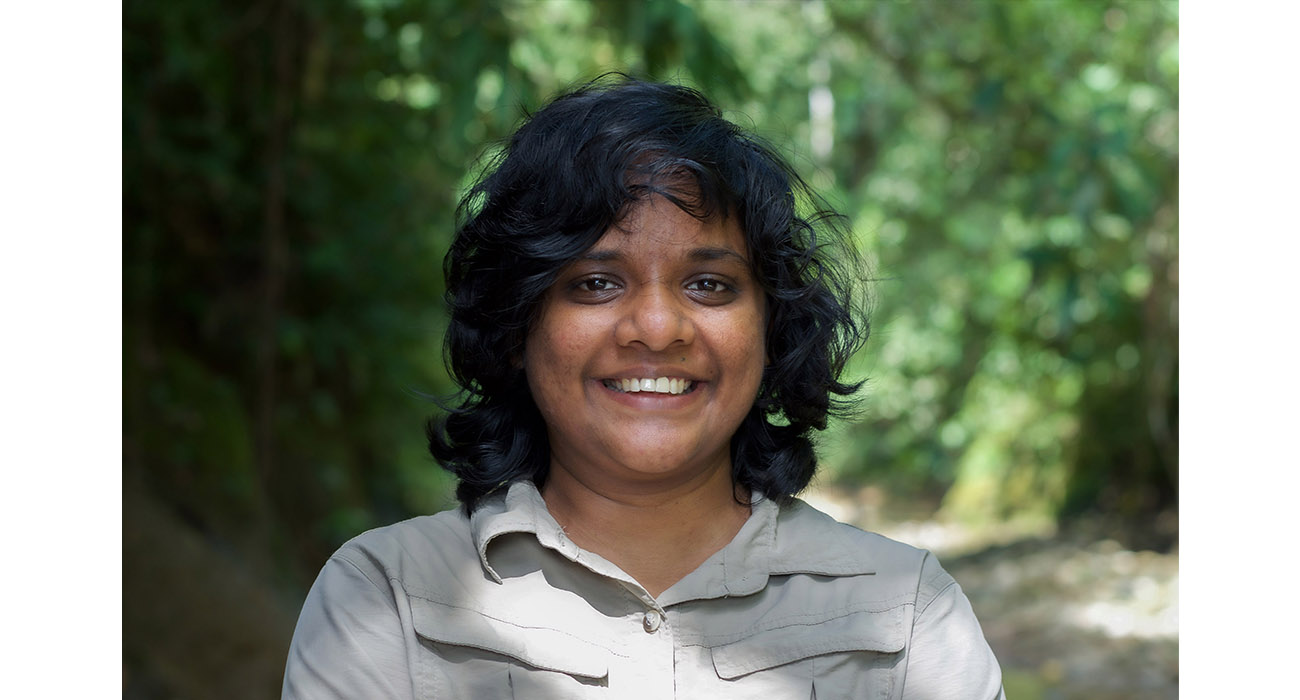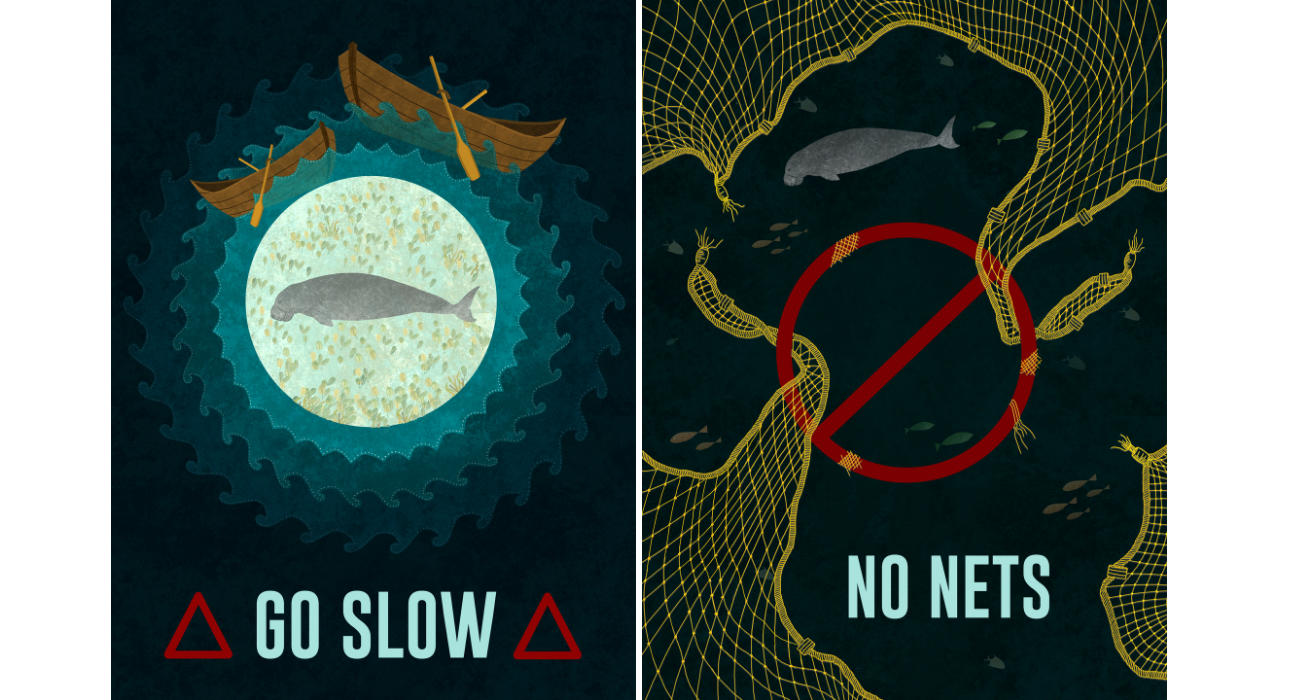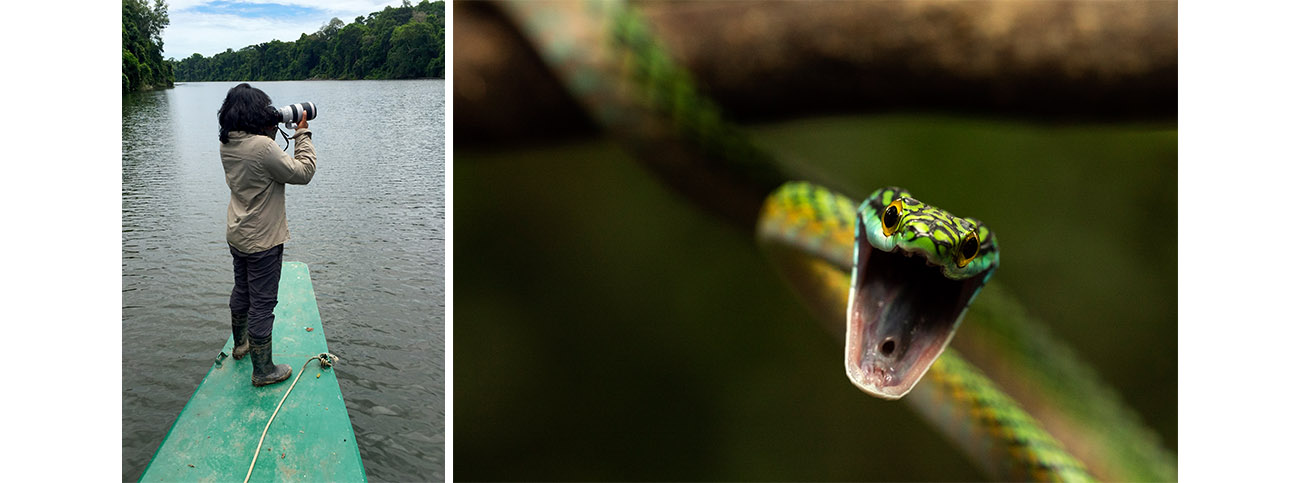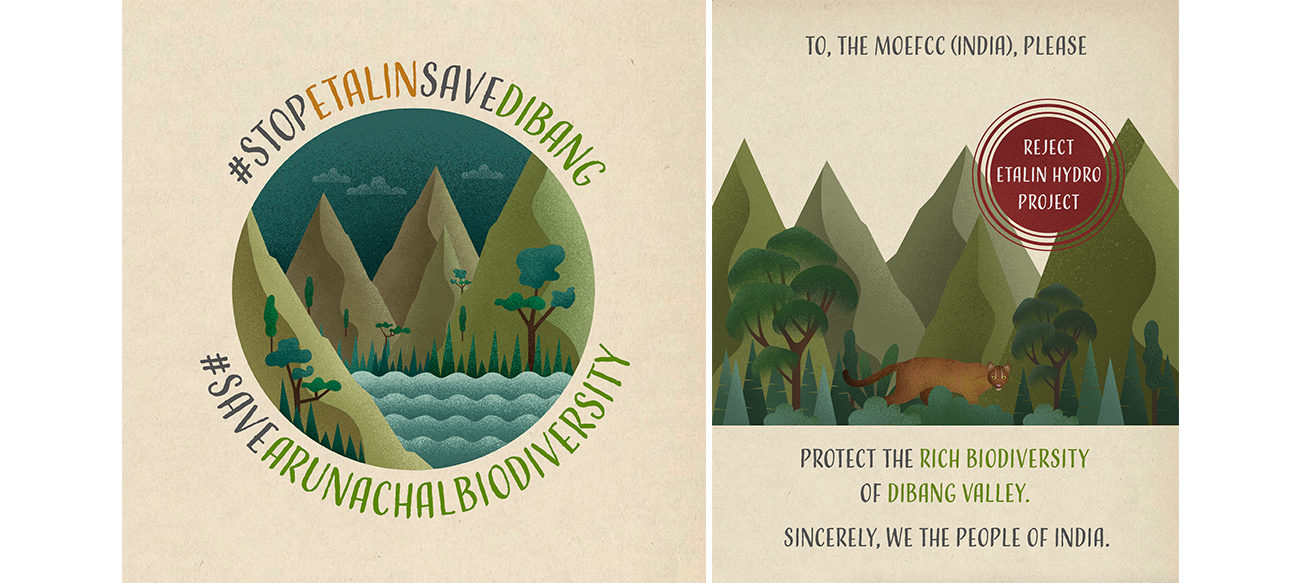"My Fears Were Subdued by Curiosity": Getting Creative with Pooja Gupta
First published on
June 03, 2021
In 2013, recent design school graduate Pooja Gupta hesitantly quit her desk job and moved to the Andaman Islands to work at a research station. Since then she has used her skills in design thinking as an illustrator, graphic designer, film maker and animator to tell conservation stories, translate jargon-filled research, and boost environmental campaigns. A recent recipient of the Jackson Wild Emerging Filmmaker Summit Scholarship, Pooja is one of a new rank of creative conservationists who use multimedia to impact the world they inhabit. She chats with Sanctuary’s Cara Tejpal about why conservation needs creativity.

Photo courtesy: Grace Cavanagh.
Let’s start with the most obvious question. Your website says that you’re a multimedia artist working on science and environmental communications. What exactly does that mean?
To put it in simple terms, the idea is to do everything in my ability as an artist to communicate all things environment and science to public and non-scientific audiences. Using the power of visuals, I constantly seek to communicate complex issues in a manner that is both aesthetic and easy to understand. Often, the goal is to make information fun, accessible and relatable to all.
When and where did you consciously begin to foster your love for the natural world? How did you nurture it?
I’m afraid I don’t have those typical childhood dreams of romanticised nature to back me up on this one! I grew up in the streets of Hyderabad, and all I can remember is playing a whole lot of gully cricket, hide-n-seek and the like. The landscape changed drastically as I grew up, and is now dominated by multi-storeyed buildings with no room to play. It feels like the sense of community that was present during my childhood has been lost to these concrete structures.
It was much later, after studying design and film at Srishti Institute of Art, Design and Technology in Bengaluru, that I decided to try making educational films on wildlife and nature. I had an urge to travel and experience something different. With a lot of trepidation and 'what ifs', I quit my job to take up an opportunity that allowed me to explore. In 2013, I left to work at a research station, ANET, in the Andaman Islands.
Once I was there, my fears were quickly subdued by curiosity. I was immediately hooked to the stunning surroundings, and my passion grew at a fast pace. A sense of community and belonging returned and I felt connected to the present moment. It was around then that I consciously started to foster my love for the natural world. Ever since, I’ve had no regrets about choosing this path of work no matter what hurdles I’ve had to cross. It’s a lifestyle more than a career, and it challenges me to constantly adapt and pave my own path.
You’ve had the privilege of working with many very credible organisations. Tell me about some of the collaborations that were particularly fulfilling for you?
I’ve definitely had the good fortune to work with several credible organisations, both locally and internationally. I couldn’t be more grateful for all the learnings that these have brought. To name a few… The Andaman and Nicobar Environmental Team, Green Hub, Nature Conservation Foundation, Roundglass Sustain, CREES Foundation, and Only One. Beyond this, there are all the collaborations I’ve had with independent researchers, biologists and media makers! In 2015, I also co-founded EARTH CoLab where I worked until 2019 on innumerable initiatives.
I have a particularly affinity towards community settings such as research stations and informal learning spaces. I’ve often found myself happiest in places such as these where the right people, projects and purpose come together with a common vision! It’s like bringing the best ingredients together to create a perfectly balanced dish. I strive to find this synergy in anything I participate in or in the works that I create.
As for projects that I hold close to my heart, the first one that comes to mind is the Marine Mammals of India poster. I created it in 2016 in collaboration with marine biologist Dipani Sutaria and it is still up at several interpretation centres and used by forest departments in multiple states for identification and record keeping. It was my first illustration based art-science collaboration.
An artwork of a humpback whale painted at the Kakinada railway station in 2019 in collaboration with an Australian artist who I met via Instagram is also memorable. It’s amazing how two artists from across continents can connect so easily and work towards a singular goal.
 Left: Artwork of humpback whale in collaboration with an Australian artist Michelle. Right: Poster of Marine Mammals of India created in collaboration with marine biologist Dipani Sutaria. Courtesy: Pooja Gupta.
Left: Artwork of humpback whale in collaboration with an Australian artist Michelle. Right: Poster of Marine Mammals of India created in collaboration with marine biologist Dipani Sutaria. Courtesy: Pooja Gupta.
Another exciting project was with Nature Conservation Foundation where we used different mediums and formats to create campaign material towards protecting and safeguarding the dugongs of the Andaman Islands. We also explored the idea of biophilia and the impact it might have in creating positive change through multiple versions of a single poster. This will be used on ground in the following season.

Dugong posters for Nature Conservation Foundation. Courtesy: Pooja Gupta / EARTH CoLab.
Other projects that have been exciting are those that occur in places of learning and growth. I have taken middle-school students on educational walks to show them the cool critters in the mangroves and the intertidal zone at ANET; conducted nature journaling courses for indigenous youth learning filmmaking at Green Hub; and collaborated with Wildlife Direct to conduct a short session on nature journaling with teachers in Kenya.
Every successful project, collaboration or excited student motivates me to continue to learn, adapt and evolve while trying to keep up with this rapidly changing world.
I’m going to hazard a guess and say that it’s not easy earning a living as a conservation and science communicator, even when you have so many skills. How do you personally negotiate this reality?
Unfortunately, no, it isn’t easy. I think that the more time you spend doing and understanding this sort of work, the more you begin to see it as a lifestyle choice. That it is not just about ‘earning’ a living in a purely financial sense.
Having grown up in a joint family set-up of sorts, where every other kid in the family pursued engineering or finance, my journey as an artist in the space of wildlife and conservation came with its own set of challenges -- constant explanations for remote travels and awkward working hours for example. Ploughing through waves of self-doubt as a result of doing something that was culturally unmapped, and re-aligning goals and purpose, became an inevitable part of the deal.
Nevertheless, my parents, having had to build and carve out their own jobs and careers, inspired strength, confidence and freedom to pursue my passions. It’s been a classic case of do what you want as long as you promise to work hard and do it well! In fact, their support goes far beyond any financial measure and for that I’m eternally grateful.
I was lucky to have had the luxury of time and a certain amount of financial ease during the initial years and admittedly have worked on barter many a time when I’ve believed in the value of the project whether for impact, for my own growth or for the joy of it. But, this doesn’t have to be the case, in hindsight I know that if one keeps at it, it can be financially sustainable without giving up on much else.

Pooja Gupta while rafting along the Manu River, Manu National Park, Peru, all geared up to document the astonishing biodiversity of the Amazon rainforest, including species such as the giant river otter, howler monkey, tiger-striped frog, and parrot snake (above). Photos Courtesy: Pooja Gupta.
I think that the key is to find a way to say NO to free work, and to work at de-normalizing barters. I might be asking for too much, but a little bit of a systemic haul especially for those starting out is essential if we want more folks to pursue creative conservation.
As for how my skills fit into this dynamic, they are really just tools in the bag. The flexibility I have with shifting art forms and mediums is great for two reasons - I have more opportunities to choose from, and I am able to adapt to multiple situations. For instance, being at my desk for the better part of this last year and a half led to more art work than film work. In a world where going out has become difficult this has proven to be such a boon! Another interesting aspect is that I don’t always have to find clients, I can afford to indulge in a self-initiated art project with just the tools on my desk. Often, these projects bring rewards and finances in at a later stage. It’s time worth investing as they mark periods of self-growth.
It really helps to know what you are chasing for yourself and to then make decisions and financial goals in line with that. I cannot deny that the build-up towards a sustainable career is very slow, and I had the rare privilege of time to figure out how to make it work. For me, like for many artists, my state of mind is reflected in my art and it is of utmost importance that I’m at peace with all aspects of life for work to unfold smoothly as it’s all interlinked.
Are conservation and art grants available in India and around the world? I think a few suggestions and some advice on this will be appreciated by those keen on this barely-trodden path.
I think one needs to keep an eye out for grants, fellowships and scholarships. There are a fair few known and popular ones within the industry. National Geographic tends to have an open call every year, Habitats Trust, Save Our Seas Foundation, Creature Conserve, Jackson Wild, PSBT are a few others that come to mind. As for suggestions, I’d say reach out to past awardees, look for samples, get your applications reviewed by mentors and friends, edit, refine and tweak until you have a clearly structured and sound proposal in your hand. It helps to keep portfolios and CVs updated so you are always prepared to make last minute applications of which there will be quite a few! Most folks in the industry are willing to help and support, I’d say don’t hesitate to reach out. Writing that e-mail is not as difficult as you might think.
What’s your personal favourite medium to work in?
What excites me is the concept and the purpose behind the artwork. Once that is figured out, medium only becomes a method to achieve stylistic choices or other goals. If I’m working on something creative, alive and exciting then I enjoy the medium no matter what and I’m also happy to learn new tools and mediums as required.
I don’t think I’d be able to find solace for too long in any single medium or method. I like dynamic days, months and years with a lot of freedom. It’s the creative process that keeps me going as much as the purpose and goal. Thus my seemingly chaotic range of work that is hard to fit into any already defined box.
These various projects must have taken you to so many beautiful wild places. Tell us a memory that springs to mind.
If my friends are reading this, I can bet my life that they have sheepish grins on their faces as they have flashbacks to the travel misfortunes I’ve had! But, I’ll stick to the beautiful. Full moon nights, wading through the waters of mangrove forests in the Andamans, monsoon nights in the rainforests of Coorg, chasing frog calls in the middle of the Peruvian amazon, building precarious human jungle gyms amidst the dense jungles in search of new frog species. All of this and so much more.
We were once filming Malabar pit vipers and Malabar gliding frogs in Coorg. We’d identified a spot where a pit viper would perch at the same time every day. On the clock. Around this, in varying combinations depending on the day, were a cat snake, two other pit vipers, leeches, a black scorpion with three babies on its back and an orchestra of frogs.
A little before 8 p.m. each evening we’d find a small patch of bare ground to setup our cameras and umbrellas on, and then let the events unfold around us. It was like watching a TV show made just for us. The soundscape, the action, the hunts, the misses and the drama that those slithering beauties and the frogs put up for us each night was exhilarating. I get goosebumps thinking about it even now.
It’s experiences like these that keep me hooked. Though I have to admit that a calm wade through the mangroves that might seem relatively dull compared to this is actually equally, and sometimes more, enthralling than a place full of sound and chaos. I love it all and in this moment, as I write, I miss it all!
_1622784331.png)
Kayaking through the mangroves of North Wandoor, Andamans Island. Pooja and her team would set out to film the play of light while maneuvering through the shallow creeks of the sanctuary for a short educational film about the mangrove ecosystem. Photo courtesy: Pooja Gupta.
I feel more and more people are appreciating the role of conservation art. Can you share a recent example where multimedia communication has been impactful to conservation?
YES! And it feels great.
I’d like to bring focus to the power of people and good leadership here. There were several campaigns launched in the country last year that invited a great deal of public participation.
There’s MyMollem or Save Mollem led by a host of citizens such as Nandini Velho, Svabhu Kohli, and Gabriella D’Cruz. Save Vedanthangal and Save Pulicat that found a champion in Yuvan Aves, and so many more. Personally, I took on deconstructing and visualising arguments for the Save Dibang Valley campaign, against the proposed Etalin Hydro Project in Dibang Valley.
For each of these campaigns, researchers, scientists, other subject experts and student groups have come together for the protection of invaluable habitats. It’s been exciting to see an ocean of artists communicate these causes. In 2020, it led to an unprecedented uproar on social media platforms, bringing the issues to everyday audiences in ways that we hadn’t seen before.

Posters for the Etalin Hydroelectric Project Campaign. Courtesy: Pooja Gupta.
Last, question! What are you working on right now?
It so happens, that I never have one answer to this question! I always have a few projects underway: self-initiated, client-based, those with a long-term vision, and so on.
The most exciting and recent project is an art sale I’ve initiated with a friend’s help to raise relief funds for the Karen community in the Andamans. These are some of the folks who taught me how to navigate the natural world and who have inspired me in more ways than one. I’m selling prints from a collection of my marine artworks for this, which you can view here.
Simultaneously, I’m working on some graphics for Trippintoe media, science illustrations for Only One, and prototyping interactive digital textbooks with Green Hub. Like I said, it’s as mixed up as ever with more ideas and collaborations brewing all the time. A few years into it, I can now say with confidence that I’ve found a method to the madness and cannot imagine my days in any other way.
_1622710988.png)
Courtesy: Pooja Gupta.
Cara Tejpal leads conservation initiatives for Sanctuary Nature Foundation and is a commissioning editor for Sanctuary Asia magazine.



 Left: Artwork of humpback whale in collaboration with an Australian artist Michelle. Right: Poster of Marine Mammals of India created in collaboration with marine biologist Dipani Sutaria. Courtesy: Pooja Gupta.
Left: Artwork of humpback whale in collaboration with an Australian artist Michelle. Right: Poster of Marine Mammals of India created in collaboration with marine biologist Dipani Sutaria. Courtesy: Pooja Gupta.

_1622784331.png)

_1622710988.png)